Pleven - a common Bulgarian variety grape. Among its positive characteristics, summer residents include exceptional cold resistance, large-fruited, good taste of berries. Meanwhile, many winegrowers note that the variety is susceptible to diseases and pests, it is extremely demanding on the growing conditions. Pleven includes two more advanced varieties - Muscat and Sustainable. It is they who are selected by vine growers to plant on their plots.
Content
general description
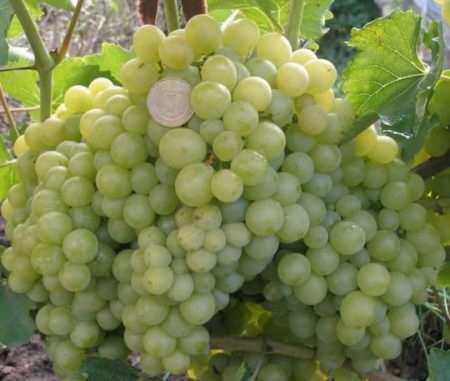 Variety Pleven and all subspecies belong to table grapes. Berries are consumed fresh, made from them compotes and homemade wine.
Variety Pleven and all subspecies belong to table grapes. Berries are consumed fresh, made from them compotes and homemade wine.
The initial variety Pleven is a strong-growing branchy bush with shoots that are characterized by early ripening. The grapes are large, oblong-rounded, weighing 5-6 grams. The skin is thick, light green, golden, matte. The pulp is juicy with the presence of 6-8 large seeds. Fruit they are collected in small loose cone-shaped brushes, which weigh an average of 350-450 grams. Productivity is above average, and is about 60 kilograms per adult shrub.
The traditional variety is less hardy than it is collected, however, it winters quite successfully under shelter. Pleven is susceptible to fungal infections and certain types of pests.
All varieties of Pleven have early ripening (110-120 days). Young bushes begin to bear fruit in the third year of life, and peak productivity occurs in 5-8 years. Harvest ripens by mid-August. Ripe berries can hang on the bush for a long time, not deteriorate or crumble.
Flowering Pleven bisexual. Pollination occurs in any weather, the fertilization of flowers -100%.
Muscat Pleven
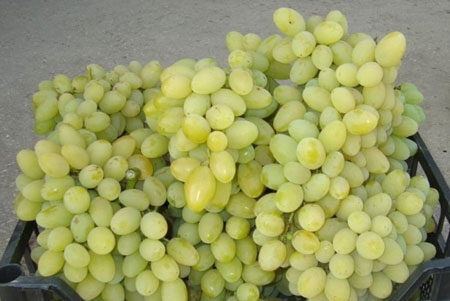
This variety of Pleven was bred by crossing the Druzhba and Strashensky grapes. The resulting form has early ripening, stable immunity to fungal diseases, a high percentage of shoot maturation.
Muscat Pleven is a strong-growing, heavily leafy bush with powerful long climbing vines. On each shoot 2-3 weighty clusters are formed, weighing 600-800 grams.
The berries of the Muscat variety Pleven are oval, pale yellow, almost white. Their mass is 6-8 grams. The skin is dense, elastic. The inside is juicy, fleshy, with a small concentration of seeds. The taste is pleasant muscat.
The variety has good productivity - up to 15 kilograms per bush. The grapes are frost-resistant, successfully winters without shelter at temperatures up to -15 degrees. For cold and light snowy winters, shelter is recommended.
Muscat Pleven is popular among summer residents for the excellent taste of berries. This grade easy to propagate, because the cuttings have a good survival rate. Rooted seedlings very quickly build up shoots in the summer.
Pleven steady
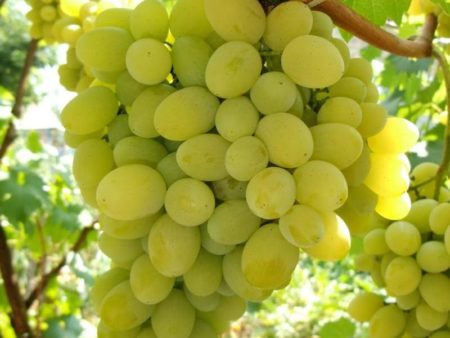 Also known by other names - Augustine and Phenomenon. These subspecies are derived from Pleven and Villard Blanc. A stable variety has good winter hardiness and excellent health.
Also known by other names - Augustine and Phenomenon. These subspecies are derived from Pleven and Villard Blanc. A stable variety has good winter hardiness and excellent health.
Ripening occurs in mid-August. Harvest can be harvested until the end of September. A fruiting two-three year old bush can produce up to 30 kilograms of delicious berries. They gather in loose volumetric clusters of conical shape, which weigh up to 500 grams.The berries themselves are small, weighing 5-6 grams. Their skin is light green, soft, almost transparent. All fruits have the same size, among them there are no peas or underdeveloped berries.
A stable variety of grapes is unpretentious in care. With mild snowy winters you can not hide the lashes - they can easily withstand frosts down to -10 degrees.
Growing Features
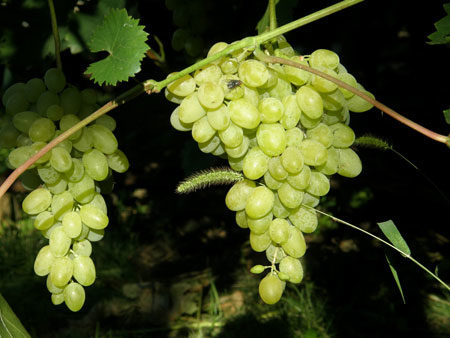 Many gardeners claim that raising Pleven is not difficult. Yes, it requires care and attention on the part of a person, but in response thanks a tasty and plentiful harvest. Experts say that this grape grows on almost any soil, but it shows the best results on loam and chernozem. In addition, while the absolute number of varieties of this culture prefer sunny areas, Pleven can grow and develop well in light partial shade. Moreover, it is noted that during the ripening period the berries are often damaged (wilted) in the sun, so you have to shade the shrub to preserve the marketable appearance of the berries. Pleven can be planted in the southeastern part of the garden, having a bush close to the house wall, garage or tall fruit trees. True, in this case, plants may have competition for nutrients in the ground.
Many gardeners claim that raising Pleven is not difficult. Yes, it requires care and attention on the part of a person, but in response thanks a tasty and plentiful harvest. Experts say that this grape grows on almost any soil, but it shows the best results on loam and chernozem. In addition, while the absolute number of varieties of this culture prefer sunny areas, Pleven can grow and develop well in light partial shade. Moreover, it is noted that during the ripening period the berries are often damaged (wilted) in the sun, so you have to shade the shrub to preserve the marketable appearance of the berries. Pleven can be planted in the southeastern part of the garden, having a bush close to the house wall, garage or tall fruit trees. True, in this case, plants may have competition for nutrients in the ground.
For better pollination, it is preferable for the vineyard to blow warm winds, but not to create drafts and gusts.
Grapes can be planted in early spring or autumn, in mid-September. Planting is carried out by grown seedlings or rooted cuttings. It is preferable to plant cuttings in the spring, as they take root worse and during autumn laying may not have time to take root in a new place before winter. One-year-old seedlings usually set well during autumn planting.
Both rooted cuttings and annual bushes are planted in deep holes measuring 50 * 70 centimeters. Between the holes leave a gap of 70-80 centimeters. They dig them out in the fall. At the bottom put a bucket of humus, then thoroughly mix the earth with organic matter. If the soil is dense, then the bottom is drained with expanded clay, broken brick, and only then spread organic fertilizer. In winter, the pits are covered with a film so that the compost is lit, nourishing the soil layer. In the spring a couple of weeks before planting grapes, the pits open. Provide them with compost, mullein, or chicken droppings. Then add mineral compositions, mainly phosphorus and potash.
Grapes are planted so that the base of the annual shoots is 3-5 centimeters above the edges of the pit. The roots are straightened along the bottom, preventing them from tangling and bending. Better moistened seedlings take root, so they are pre-soaked in a clay-dung mash. As the pit is filled up, the ground is periodically tamped with a foot. When two-thirds of the pit is filled with earth, a bucket of water is poured into it for better moisture, after which it is covered with soil to the top.
Care
In order to get a decent harvest from Pleven, it is necessary to regularly carry out agricultural activities, otherwise the capricious culture will not give a plentiful the harvest. Grapes are in dire need of moist soil, phosphorus-potassium fertilizing, pruning, shelter for the winter.
Watering
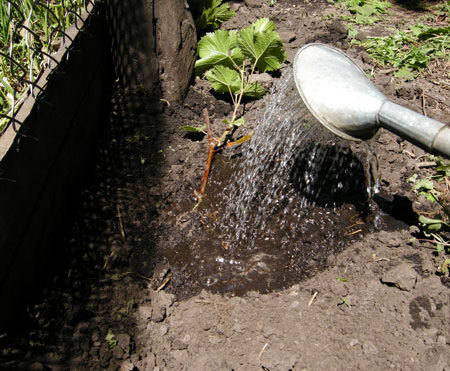
In the year of planting, plants are watered up to 14 times:
- immediately after disembarkation;
- in April - 3 irrigation;
- in May, June, July, August - 2-3 irrigation;
- in September - 1-2 watering.
In dry periods, shrubs are watered additionally, but not poured, grapes are poorly related to excessive moisture. Observations show that with frequent rainfall and prolonged waterlogging of the earth, the berries crack and rot quickly. Therefore, in regions with uneven climatewhere the number of sunny days is insignificant and precipitation falls above the norm, you have to save the vineyard through the construction of greenhouses that protect the plants from excessive moisture.
Vine bushes are not watered under the root, but in the grooves, which are arranged on the sides of the base of the stem. Pour water in a thin stream (infiltration). If the grapes are planted close to the wall of the house or the fence, then watering is carried out manually with a watering can, spending up to 5 liters of water per plant. It is important that the soil is saturated with moisture to a depth of 60-70 centimeters.
Pruning
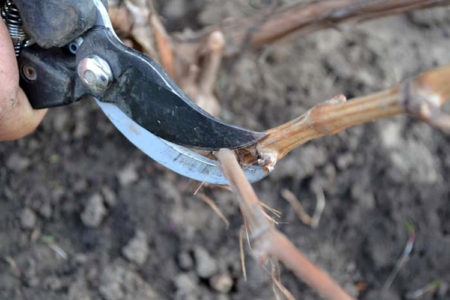 Pruning of grapes can be carried out both in spring and in autumn. If pruning is carried out in autumn, then even in the southern regions it is necessary to cover the bush for the winter, otherwise the places of cuts will freeze. In northern the regions and in central Russia, grapes are preferably pruned in spring.
Pruning of grapes can be carried out both in spring and in autumn. If pruning is carried out in autumn, then even in the southern regions it is necessary to cover the bush for the winter, otherwise the places of cuts will freeze. In northern the regions and in central Russia, grapes are preferably pruned in spring.
The annual bush needs to be formed in the spring. At the same time, 2 lower buds are left on the central shoot, the rest are removed. Two lateral shoots, vines, grow from the remaining buds. They are placed horizontally. Late in the fall, when all the leaves fall, and the green shoots are lignified, the shoots are shortened. One shoot is made short, 2 kidneys must be present on it. On the other shoot, 4 buds are left (respectively, it is longer). In spring, the stems growing from the buds are let up with a slight bias to the sides. And already at the end of the season, pruning is carried out again - only 2 shoots are left on each lash. Thus, annually the bush builds up two fruitful shoots.
Substitution knots are left to grow vertically. In the warm period, new stems will grow from all buds, which in early autumn should be cut off by 10-20 centimeters. At fruiting bushes in autumn, fructified shoots with a part of the sleeve are cut.
In addition to forming pruning, sanitary is also carried out. This type of pruning involves the removal of all diseased, damaged, frozen out and thickening bush shoots from the bush. Usually they are not completely removed, but only the part that is already incompetent. It is important that the lashes are directed to the sides, and not grow inside the crown, do not create a lignified lump that cannot be unraveled.
Top dressing
If the soil was sufficiently fertilized when planting seedlings, then grapes will not need top dressing for three years. Only adult bushes begin to feed heavily on minerals, which will have to be supplied to them regularly.
The need for various nutrient components in grape varies depending on the stage of vegetation. So in the spring, the plant needs nitrogen. This element promotes the growth of new shoots and green mass. At this time, grapes are fed with urea or ammonium nitrate, and organic fertilizers are added.
Phosphoric fertilizers, in particular superphosphate, are necessary for the culture at the beginning of flowering. The more phosphorus in the earth, the larger the ovaries will be. The ripening of vines and berries is possible due to the presence of potassium in the ground. Potassium is not only needed for grapes to ripen quickly, but also to increase immunity and cold resistance. Therefore, it is important to feed the plant with potassium chloride.
Feeding time:
- in the early spring after the opening of the bushes;
- 14 days before flowering;
- before fruit ripening;
- in the fall after harvest.
You can feed grapes with mono-and multicomponent compositions. Minerals alternate with organics. Grapes respond well to root dressing with manure, diluted mullein, compost made from grass, tops, food waste. The bird droppings diluted with water are well absorbed by culture. Instead of potassium chloride, it is permissible to add ash under grapes - its composition is less aggressive and is better absorbed by plants.
Shelter for the winter
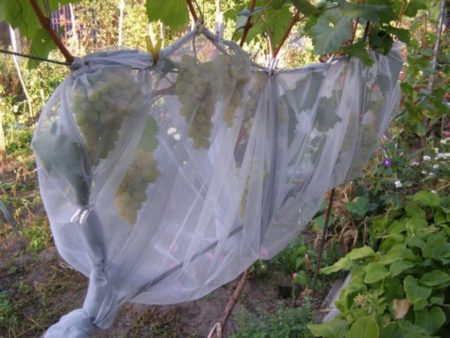 Pleven is not afraid of low temperatures, but can be severely damaged in lightly snowy and frosty winters. Therefore, it is recommended to cover all varieties of the variety during cold weather. In autumn, the vines are removed from the trellis and gently twisted, pinning to the ground. These works are carried out in mid-November, when a constant temperature will be below -5-8 degrees. The bases of the bushes can be sprinkled with sawdust, straw or dry foliage. Such a mulch will warm the roots. Above the shoots, arcs are installed, which are covered with a conventional film or agrofibre. It is important that the vines do not touch the film, otherwise it can cause a rotting process. If you are afraid of the greenhouse effect, then it is better to use another covering material, for example, spanbond or roofing material.
Pleven is not afraid of low temperatures, but can be severely damaged in lightly snowy and frosty winters. Therefore, it is recommended to cover all varieties of the variety during cold weather. In autumn, the vines are removed from the trellis and gently twisted, pinning to the ground. These works are carried out in mid-November, when a constant temperature will be below -5-8 degrees. The bases of the bushes can be sprinkled with sawdust, straw or dry foliage. Such a mulch will warm the roots. Above the shoots, arcs are installed, which are covered with a conventional film or agrofibre. It is important that the vines do not touch the film, otherwise it can cause a rotting process. If you are afraid of the greenhouse effect, then it is better to use another covering material, for example, spanbond or roofing material.
Protection against diseases and pests
Pleven often suffers from the negative effects of pests. Leaves are often affected by phylloxera. This microscopic aphid destroys the leaf component of the bush. Females lay numerous offspring on the underside of the leaf plate, which the same offspring subsequently eats. Wandering larvae quickly spread throughout the bush, reducing its productivity, halting development. When phylloxera appear on grape bushes, they primarily carry out preventive measures: cut the affected areas, replace the upper soil layer, sprinkle the area with sand, including the inner layers where the root is. With strong reproduction, aphids use strong pesticides such as carbon disulfide, Marshall, Confidor, Actellik, Mitak.
Causes severe damage to the crop It is also called a bunch of leaves. This small whitish butterfly lays eggs on the stems, leaves and buds of plants. Of them, after a couple of weeks, gluttonous caterpillars hatch olive-colored. They feed on buds, flowers, and ovaries of grapes. Caterpillars of the second and third generation feed on the berries themselves. It is possible to fight with clapperbirds with the help of biological agents (Karate, Alstara, Danadim, Fury and others). Of the chemical agents, Actellik and Fosbecid are the best copers with the butterfly.
Sometimes on the underside of the leaves, lesions of the whitish color of the "spider" structure can be detected. So develops a fungal disease - mildew - the most dangerous for grapes. Depending on the temperature and humidity, the foci may be brown, yellow, dirty brown. The fungus causes necrosis of the leaf plate. The leaves fade and fall, which leads to a general weakening of the bush and a halt in its development. The causative agent affects not only the leaves, but also the stems, ovaries and fruit - White oily spots appear everywhere. You can overcome mildew if you notice just appeared painful foci in time. Just then you need to start chemical spraying. Processing plants is carried out before flowering. However, if the disease continues to develop during color, then copper-free preparations are used. The main drugs for suppressing infection are Home and Abiga Peak.
Pros and cons of the variety
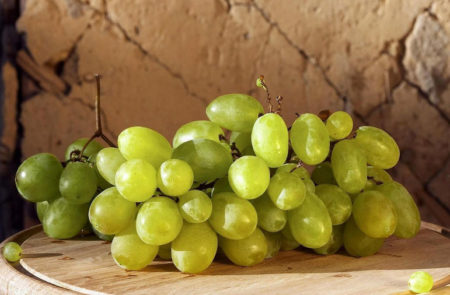
Pleven is a traditional grape variety, which, along with a host of advantages, also has some disadvantages. Of the positive characteristics of winegrowers are usually noted:
- rapid growth of shoots and their good ripening;
- simple and effective reproduction;
- berries are rarely damaged by wasps due to the sturdy thick skin.
The disadvantages include:
- low sustainability to infections;
- the presence of large bones in the pulp;
- demanding plants for watering;
- fast drying of berries in direct sunlight.
Gardeners reviews
They grow Pleven Muscat.
The variety has proven itself by the fact that it is very rarely sick, it is not affected by pests. Homemade wine from it is amazing. In the garden, two bushes grow. On each, 15-17 clusters are formed. Their weight is approximately 700 grams. Bunches can hang for a long time in a ripe form, do not crumble. Long retain the taste and marketable appearance.
Denis
Pleven grapes have practically no shortcomings. He practically does not require leaving, I feed once a year, in the spring. It never hurts, it winters well, though under cover. Grapes ripen by the end of summer. It ripens for a long time, but it's worth it. The taste of berries is excellent. Do not acid, sugar in moderation. You can easily make wine or compotes. Once I tried to propagate, it turned out. All cuttings are rooted. Quickly went to growth, there was no waste. In general, a very decent variety.
Conclusion
Pleven is a rather unpretentious, high-yielding grape variety. The taste of its berries tends to be more mediocre, but most summer residents are satisfied with the sweetness and large size of the fruit. It is not difficult to grow grapes, and even without making an effort, you can annually get a good portion of voluminous beautiful clusters, which can also be stored for a long time without losing their external attractiveness and balanced taste.




 Non-covering winter-hardy grape varieties for Moscow region
Non-covering winter-hardy grape varieties for Moscow region How to keep the vine in winter
How to keep the vine in winter When can I transfer grapes to another place in the fall
When can I transfer grapes to another place in the fall How to cover and prepare grapes for the winter in the suburbs
How to cover and prepare grapes for the winter in the suburbs